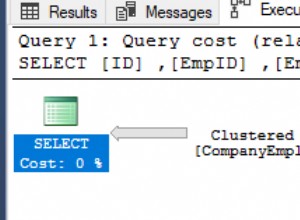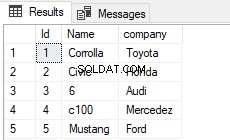Ich habe das mysql-Tag verpasst und diese Lösung geschrieben. Leider funktioniert dies nicht in MySQL, da es keine Fensterfunktionen unterstützt .
Ich poste es trotzdem, da ich mir Mühe gegeben habe. Getestet mit PostgreSQL. Würde ähnlich mit Oracle oder SQL Server (oder jedem anderen anständigen RDBMS, das Fensterfunktionen unterstützt) funktionieren.
Testaufbau
CREATE TEMP TABLE v(id int, visit date);
INSERT INTO v VALUES
(444631, '2011-11-07')
,(444631, '2011-11-06')
,(444631, '2011-11-05')
,(444631, '2011-11-04')
,(444631, '2011-11-02')
,(444631, '2011-11-01')
,(444632, '2011-12-02')
,(444632, '2011-12-03')
,(444632, '2011-12-05');
Einfache Version
-- add 1 to "difference" to get number of days of the longest period
SELECT id, max(dur) + 1 as max_consecutive_days
FROM (
-- calculate date difference of min and max in the group
SELECT id, grp, max(visit) - min(visit) as dur
FROM (
-- consecutive days end up in a group
SELECT *, sum(step) OVER (ORDER BY id, rn) AS grp
FROM (
-- step up at the start of a new group of days
SELECT id
,row_number() OVER w AS rn
,visit
,CASE WHEN COALESCE(visit - lag(visit) OVER w, 1) = 1
THEN 0 ELSE 1 END AS step
FROM v
WINDOW w AS (PARTITION BY id ORDER BY visit)
ORDER BY 1,2
) x
) y
GROUP BY 1,2
) z
GROUP BY 1
ORDER BY 1
LIMIT 1;
Ausgabe:
id | max_consecutive_days
--------+----------------------
444631 | 4
Schneller / Kürzer
Später fand ich einen noch besseren Weg. grp Zahlen sind nicht kontinuierlich (sondern kontinuierlich steigend). Macht nichts, denn das sind nur Mittel zum Zweck:
SELECT id, max(dur) + 1 AS max_consecutive_days
FROM (
SELECT id, grp, max(visit) - min(visit) AS dur
FROM (
-- subtract an integer representing the number of day from the row_number()
-- creates a "group number" (grp) for consecutive days
SELECT id
,EXTRACT(epoch from visit)::int / 86400
- row_number() OVER (PARTITION BY id ORDER BY visit) AS grp
,visit
FROM v
ORDER BY 1,2
) x
GROUP BY 1,2
) y
GROUP BY 1
ORDER BY 1
LIMIT 1;
Mehr
- Ein Verfahrenslösung
für ein ähnliches Problem.
Möglicherweise können Sie etwas Ähnliches in MySQL implementieren . - Eng verwandte Antworten auf dba.SE mit ausführlicher Erklärung hier und hier .
- Und auf SO:
GROUP BY und aggregierte sequentielle numerische Werte




